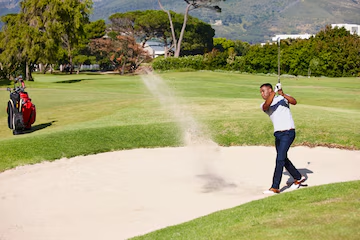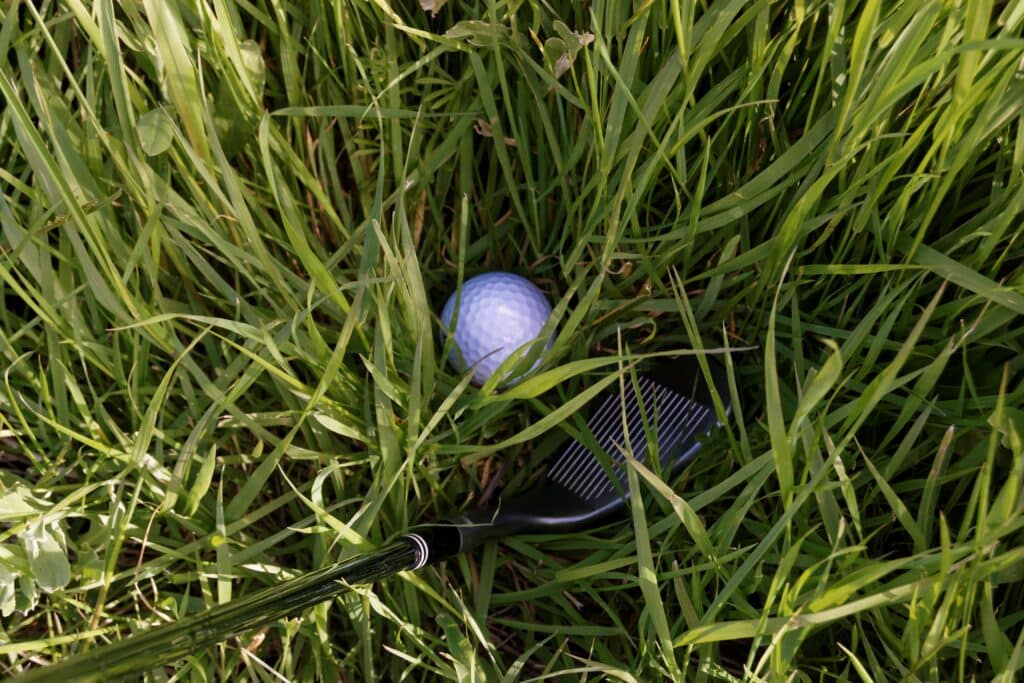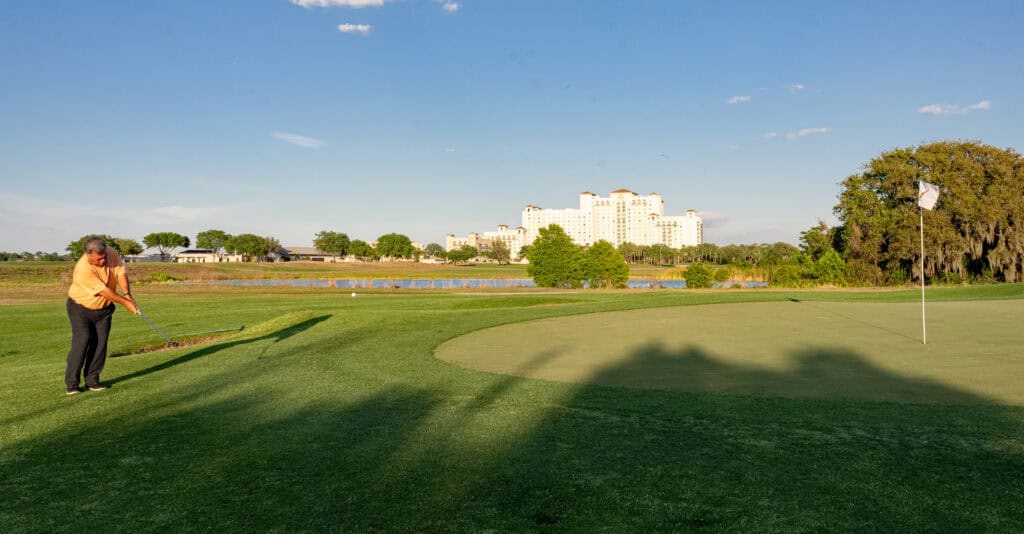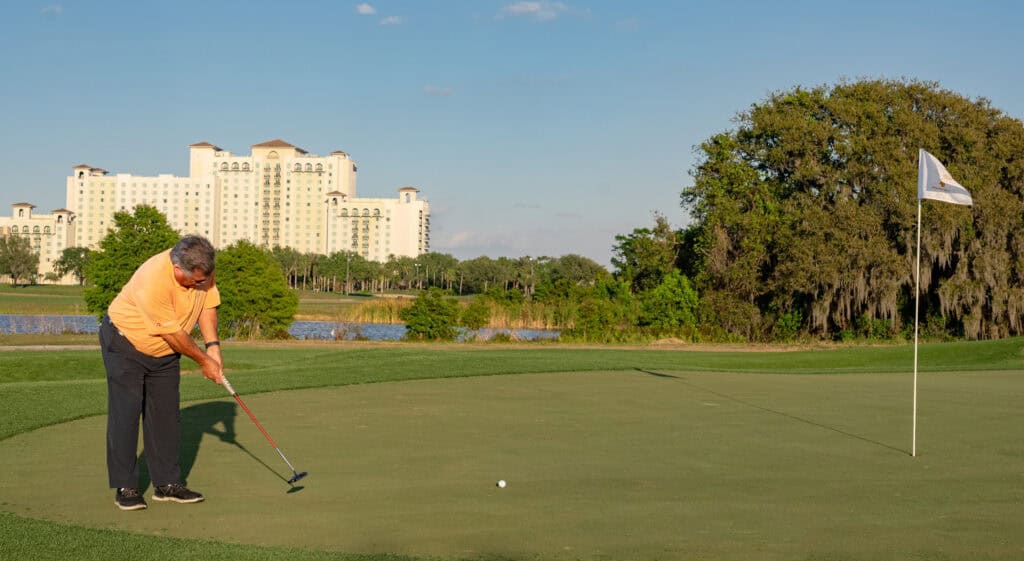Tips for Lowering Your Score on Par 3’s
Whether you’re a weekend warrior or a seasoned golfer, mastering the third shot on par 3 holes can dramatically improve your scores. Often overlooked, this pivotal stroke can transform a potential bogey or worse into a par. Setting the tone for the rest of your round. Improving a golfer’s ability to improve their third shot on par 3 holes is a coaching staple for John Hughes Golf within any beginner golf school or advanced golf school program we conduct.
Understanding the unique challenges of par 3’s, from varying distances and wind conditions to green slopes, opens the door to improved performance. Within this post, which is Part 2 in the series “The 3rd Shot is the Most Important Shot in Golf,” we’ll share expert tips and strategies designed to help you approach your third shot on par 3 holes with confidence and precision. You’ll discover how to select the right club, perfect your aim, and read the green like a pro. By honing this skill, you’ll not only save strokes but also elevate your overall game. Get ready to take your performance of your third shot on par 3’s to the next level! And watch your scores drop!
Understanding the Importance of the Third Shot to Par 3 Holes

Par 3 holes, often considered the shortest yet trickiest holes on a golf course, require an effective and efficient strategy that leads to ultimate precision, to score your best.
Many golfers focus on making birdie on par 3’s, over estimating their ability to precisely land their tee shot close enough to the hole to make this possible. Doing so as an amateur golfer most often leads to your third shot on par 3 holes being equally critical, if not more important, to determining your score. The third shot on par 3 holes can either salvage a par. Or rescue you from making a big number, directly impacting your confidence and momentum for the remainder of the round. Understanding its importance is the first step toward mastering it.
Your third shot on par 3 holes happens when your first and second shots don’t go as planned. Whether it’s due to a poor tee shot that misses the green. Or a challenging lie for a short game shot to save par. Your third shot on a par 3 must be your saving grace. This shot demands accuracy and a keen understanding of the green’s dynamics. By honing this particular skill, golfers can turn what might be a frustrating hole into a manageable or even advantageous situation, setting the stage for a more successful round overall.
In addition, mastering the third shot on par 3 holes can and will significantly lower your overall score by minimizing the number of bogeys or worse you score on these holes. Many golfers underestimate the potential of this shot, thereby missing out on opportunities to improve their score. By focusing on perfecting this aspect of your game, you enhance your ability to recover from less-than-ideal situations, ultimately distinguishing you from other players who might overlook this pivotal part of the game.
Analyzing Common Challenges Faced on Par 3 Holes
Par 3 holes present unique challenges that can perplex even the most seasoned golfers.
One of the primary difficulties lies in the varying distances that these holes can feature. Unlike longer holes where distance might be more consistent, par 3s can range from short pitches to longer iron shots, requiring a deep understanding of your club capabilities so you can deal with the variations of this shot. Strategizing for variability demands precise shot-making. Your minor miscalculations can lead to challenging situations.
Another significant challenge is the wind conditions often encountered on par 3s. Your tee shots to par 3’s are often influenced by predictable wind tendencies as well as the unpredicted. This complicates club selection and shot execution. A gust of wind can easily push a well-struck ball off course, causing it to land in a bunker or rough, making your third shot even more crucial. This unpredictability necessitates an acute awareness of the weather and an ability to adjust your strategy accordingly.
In addition, the design of par 3 greens often includes strategic slopes and undulations, adding an extra layer of complexity to your approach. These features can turn a seemingly straightforward putt into a daunting task if not approached with precision and foresight. Understanding the green’s topography is essential for planning your third shot, as it ensures that you are placing the ball in the most advantageous position for an optimal putt. Mastering these challenges is integral to improving your performance on par 3s.
Key Factors Influencing Your 3rd Shot Performance
Several key factors directly impact the performance of your third shot on par 3 holes.
The one most important element that affects this shot is your lie. The condition and position of the ball, whether nestled in the rough or perched on a tight lie, dictates the type of shot you must execute. Analyzing your lie accurately allows you to choose the appropriate club and shot type, minimizing the likelihood of errors and maximizing your chances for a successful outcome.

Distance control is another vital factor that can make or break your third shot. Unlike longer holes where power is more of a necessity, par 3s demand precision and the ability to accurately gauge yardages. Misjudging the distance can result in overshooting or coming up short, both of which can be costly. Developing a keen sense of distance through practice and the use of rangefinders or GPS devices can significantly enhance your ability to execute your third shot effectively.
In addition, the condition of the green plays a crucial role in your third shot on par 3 holes. Fast greens require a delicate touch, whereas slower greens might demand a more aggressive approach. Understanding how the ball will react upon landing and accounting for speed and break are essential skills to cultivate for successful putting. By considering these factors, you can tailor your approach to each unique situation, ultimately improving your third shot execution and lowering your scores on par 3 holes.
Essential Techniques for Improving Your 3rd Shot on Par 3 Holes
Improving your third shot on par 3 holes involves mastering a set of techniques that can adapt to different situations.
One fundamental technique all golfers must be very adept with is a chip shot. Or sometimes referred to as a bump and run. This shot is a very useful weapon in your arsenal of shots from almost anywhere on the golf course. Particularly around the green. Chip shots require a controlled swing with several different clubs ranging from wedges to lower lofted clubs, such as a hybrid. Knowing how to use each to produce a soft landing and subsequent roll on the green towards the hole is what all golfers need. Practicing this shot can significantly enhance your ability to save par when your tee shot doesn’t find the green.

Another essential technique is a pitch shot, or sometimes a flop shot. This shot requires more preciseness from you and can be a savior in situations where you need to get the ball over an obstacle with limited green to work with. This high-lofted shot demands a precise and confident swing, ensuring that the ball lands softly on the green. While it can be a challenging shot to master, incorporating it into your repertoire can provide you with more options when faced with tricky third shots.
Additionally, focusing on your putting technique can greatly improve your third shot performance on par 3s. Most of your third shots on par 3’s should be putts. Whether right next to the hole or a significant distance away, having a putt for your third shot on a par 3 is a blessing. But can sometimes be an ugly result if you can’t control distances with your putter. While being able to square the face of the putter to your intended target.
Your ability to read greens accurately and execute putts with the right speed and line is crucial for converting those third shots into successful outcomes. You’re going to need to practice various putting drills that simulate different green conditions can help sharpen your skills, making it easier to sink putts when it matters most. Mastering these techniques ensures you are well-equipped to handle the diverse scenarios that par 3 holes present.
The Role of Club Selection in Your 3rd Shot Strategy
Club selection is a pivotal aspect of executing an effective third shot on par 3 holes. The right club can make the difference between landing softly on the green or landing far past your intended target.
Understanding the role each club in your bag plays in making your third shot to a par 3 easier to manage is critical. How each club makes the ball react on the green from different lies and conditions is fundamental to making informed decisions that enhance your scoring potential.
One of the primary considerations in club selection is the distance you need to cover. Shorter distances for the most part call on your to use a wedge. Doing so offers greater spin control, allowing you to stop the ball quickly. But you don’t always need your most lofted club to properly execute shots from shorter distances. Being able to alter your set up, as discussed in a previous post, for all clubs allows you more choices of lefts and bounce angles to choose from to make your shorter shots more accurate.
For longer third shots, you might opt for a mid-iron that provides a balance of trajectory and distance. Familiarizing yourself with the capabilities of each club through practice and experimentation is crucial for determining the best choice for any given scenario.
The conditions of the green will influence your club selection. If you’re playing a golf course with firm and fast greens, opting for a club that allows you to land the ball softly is a must. Conversely, for slower and softer greens, a club that provides more roll might be preferable.
Additionally, wind conditions should factor into your decision, as certain clubs are better suited to cutting through the wind or maximizing carry. By mastering club selection, you can approach your third shot with confidence, knowing you’ve chosen the best tool for the job.
Practicing Your Third Shot on Par 3 Holes: Drills and Exercises
Regular practice and specific drills emphasizing game like conditions is essential to refining your performance potential with your third shot on par 3 holes.
One effective drill is a distance control practice, where you set up various distances from the green and aim to land your shots within a specific target area. This exercise helps develop your ability to gauge yardages accurately and adapt your swing to different distances, a key skill for managing third shots effectively.
Another beneficial drill is the up-and-down challenge. Set up various scenarios around the green, such as bunker shots, rough lies, and tight lies, and practice getting the ball up and down in two shots. This drill mimics real-world situations you may encounter on par 3 holes, improving your problem-solving skills and boosting your confidence in executing third shots under pressure.
Additionally, dedicating practice time to putting drills can enhance your third shot performance. Focus on lag putting drills that improve your ability to judge distances and pace. As well as short putt drills that hone your accuracy and confidence. By incorporating these exercises into your practice routine, you can develop a more well-rounded skill set that enhances your third shot execution and overall performance on par 3 holes.

Mental Game: Building Confidence for Your Third Shot on Par 3 Holes
The mental aspect of golf is often what separates great players from good ones. Especially when it comes to executing crucial shots like the third shot on a par 3.
Confidence plays a vital role in your ability to perform under pressure, and building a strong mental game can help you approach each shot with the belief that you can succeed. Visualization is a powerful tool for enhancing confidence; by visualizing the desired outcome before you take your shot, you create a mental blueprint for success.
Another key component of a strong mental game is maintaining focus and composure. It’s easy to become distracted or frustrated after a less-than-ideal first or second shot, but learning to stay present and focused on the task at hand is essential. Techniques such as deep breathing and positive self-talk can help calm nerves and keep your mind centered on executing the shot to the best of your ability.
Lastly, developing a pre-shot routine is the most effective way to build consistency and confidence in your third shot execution. A routine that includes evaluating the lie, selecting the club, and taking practice swings can create a sense of familiarity and control, reducing anxiety and increasing your likelihood of success. By strengthening your mental game, you can approach your third shots with the assurance that you have the skills and mindset needed to perform at your best.
Course Management Tips for Par 3 Holes
Effective course management is crucial for optimizing your performance on par 3 holes.
One of the fundamental strategies is to always aim for the safest part of the green, rather than directly at the pin, unless you are confident in your ability to execute a precise shot. By aiming for the center of the green, you reduce the risk of landing in hazards or difficult positions, increasing your chances of making a successful third shot.
Another important aspect of course management is understanding the layout of each par 3 hole and planning your shots accordingly. This includes taking into account the pin position, green slopes, and surrounding hazards. By assessing these factors before you tee off, you can devise a strategy that minimizes risks and enhances your potential for a positive outcome.
Always stay aware of environmental factors such as wind direction and speed can greatly influence your approach to par 3 holes. Adjusting your strategy to account for these conditions, whether by altering your club selection or shot trajectory, can help you better navigate the challenges presented by each hole. Mastering course management ensures that you are making informed decisions that contribute to lowering your scores on par 3 holes.
Learning from the Pros: Insights and Techniques
Studying the techniques and strategies of professional golfers can provide valuable insights for improving your third shot on par 3 holes. Whether your realize this or not, the PGA Tour scoring average for par 3 holes is slightly over par at 3.06 strokes per par 3 hole.
One common trait among pros is their meticulous preparation and attention to detail. They take the time to assess their surroundings, factoring in every possible variable before making a shot decision. Emulating this level of preparation can enhance your own decision-making process and improve your shot execution.
Professional golfers also excel at maintaining composure under pressure, a skill that is particularly beneficial for third shots on par 3s. Observing how pros handle high-pressure situations and remain calm and focused can inspire you to develop similar mental resilience. Techniques such as visualization and controlled breathing are often employed by pros to maintain their concentration and confidence, and these can be incorporated into your routine.
If you’re not doing this already, you need to watch and learn how professionals execute different types of shots, such as chips, pitches, and putts. These practical examples of best practices are worth emulating. Pay attention to how they set up, their swing mechanics, and that they always hold a follow-through. Try to incorporate these elements into your own practice sessions. By learning from the best, you can refine your third shot technique and enhance your overall performance on par 3 holes.
Conclusion: Putting It All Together for Better Scores
Mastering the third shot on par 3 holes is an essential skill that can significantly impact your overall golf game.
By understanding the importance of this shot and analyzing the common challenges associated with par 3s, you can approach these holes with greater confidence and strategy. Key factors such as lie, distance control, and green conditions play a crucial role in your third shot performance, and honing your techniques through targeted practice can enhance your ability to execute these shots effectively.
Club selection is another vital aspect of your third shot strategy, and making informed decisions based on distance, conditions, and personal strengths can improve your outcomes. Building a strong mental game and employing effective course management techniques further contribute to your success on par 3 holes. By learning from professional golfers and incorporating their insights into your game, you can continue to refine your skills and elevate your performance.
Ultimately, by putting all of these elements together, you can transform your approach to par 3 holes and lower your scores. With dedication and practice, the third shot can become a reliable and rewarding part of your game, providing you with the tools to excel on the course and achieve your golfing goals.
Need help with your third shots on par 3 holes? Look no further than John Hughes Golf and our Custom Coaching Program. Or Full-Day Golf School program. Both can include on-course coaching to assist you with improving your ability to make your third shots on par 3 holes that much better. Contact us today to schedule your coaching session with us.
Want More? Check out our accompanying video!






